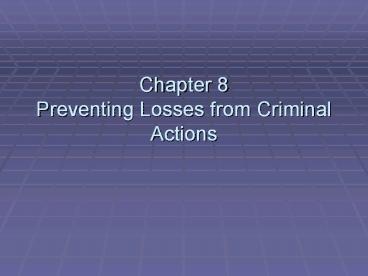Chapter 8 Preventing Losses from Criminal Actions - PowerPoint PPT Presentation
1 / 21
Title:
Chapter 8 Preventing Losses from Criminal Actions
Description:
Chapter 8 Preventing Losses from Criminal Actions Criminal and Civil Offenses A crime is an offense against the state for which punishment is sought. – PowerPoint PPT presentation
Number of Views:98
Avg rating:3.0/5.0
Title: Chapter 8 Preventing Losses from Criminal Actions
1
Chapter 8Preventing Losses from Criminal Actions
2
Criminal and Civil Offenses
- A crime is an offense against the state for which
punishment is sought. - A civil act is a tort which is an offense against
an individual for which restitution is sought.
3
Crimes Important to Private Security
- The crimes of most concern to private security
are - Larceny/theft.
- Burglary.
- Robbery.
- Trespassing.
- Vandalism.
- Assault.
- Arson.
- White collar crime--embezzlement, bad checks and
credit card fraud. - Drugs in the workplace.
4
Reducing Risk of Larceny/Theft
- Limit access to assets.
- Use basic security equipment and procedures to
deter employee pilferage as well as theft by
nonemployees.
5
Reduce Burglary Risk/Loss
- Install and use good locks, adequate indoor and
outdoor lighting and an alarm system. Can be
supplemented with security patrols. - Keep valuables in a burglar-resistant safe or
vault. - Keep minimum amount of cash on hand.
- Leave cash registers open and empty at closing
time. - Be sure all security equipment is functional at
closing time.
6
Prevent Robbery Risk/Loss
- Train employees how to react if a robbery occurs.
- Do not build up cash. Use armed couriers to
transport cash. - Establish strict opening and closing procedures,
and use extreme caution if someone seeks entrance
to facility after hours.
7
Employee Response to Robbery
- Stay calm.
- Do exactly as you are told.
- Assure robber you will cooperate totally, but do
not volunteer to do anything. - Treat any firearm displayed as though it is real
and loaded. - Activate alarms only if you can do so undetected.
- Try to alert others if possible.
8
Theft, Burglary and Robbery The Differences
- Larceny/theft--unlawful taking of property of
another without unlawful entrance or
confrontation. - Burglary--unlawful taking and unlawful entry.
- Robbery--includes unlawful taking and
confrontation.
9
Other Crime Risk Prevention Techniques
- Trespassing and vandalism can be prevented or
reduced by strict access controls, security
lighting, signs and patrols. - Adequate lighting, patrols and communication
systems are means to reduce risk of assaults.
Escort services may also be used.
10
Circumstances of Arson
- Fires that
- (1) have more than one point of origin.
- (2) deviate from normal burning patterns.
- (3) show evidence of trailers.
- (4) show evidence of having been accelerated.
- (5) indicate abnormal amount of air, fuel or heat
present. - (6) reveal evidence of incendiary igniters at
point of origin. - (7) produce odors or smoke of a color associated
with substances not normally present at scene.
11
Other Crime Types
- White-collar crime is business-related crime.
- Pilferage or internal theft is an important
concern of private security managers.
12
Common Drug Abuse in the Workplace
- Alcohol.
- Marijuana.
- Cocaine--snorted or smoked as freebase or crack.
13
Enforcement of Rights
- Security managers may be called on to enforce the
following rights - Prevent trespassing.
- Control conduct of persons legally on premises.
- Defend self, others and property.
- Prevent commission of a crime.
14
Expelling, Detaining and Arresting
- In many states, private security personnel can do
the following - Detain persons suspected of shoplifting.
- Make a citizens arrest of persons who commit a
misdemeanor in their presence. - Make a citizens arrest of persons who commit a
felony if they have probable cause.
15
Use of Force
- Force can be used only when and to the extent
that is necessary. - Deadly force can be used only to protect human
life.
16
Searching of Suspects
- Security officers usually have the authority to
search a suspects person and anything the person
is carrying if the officers have a legitimate
reason for detaining or arresting the suspect. - Any search must be conducted reasonably with the
least possible use of force, intimidation or
embarrassment.
17
Interviewing and Interrogating
- Interview--A controlled conversation with
witnesses to or victims of a crime. - Interrogation--A controlled conversation with
persons suspected of direct or indirect
involvement in a crime.
18
Effective Interviewing and Interrogating
- Prepare in advance.
- Obtain information as soon as possible.
- Use a private setting and eliminate physical
barriers. - Establish rapport.
- Encourage conversation.
- Ask simple questions one at a time.
- Listen and observe.
19
Summary Questions
- How do criminal and civil offenses differ?
- What crimes are of major importance to private
security? - How can the risks of these crimes be reduced?
- Differentiate between theft, burglary and
robbery. - What circumstances can indicate arson?
20
Summary Questions
- Define white-collar crime.
- Define pilferage.
- What drugs are commonly abused in the workplace?
- What rights can be enforced by private security
officers? - When and how can private security officers make
an arrest?
21
Summary Questions
- When is force or deadly force justified?
- When and how can searches of suspects be
conducted? - How does interviewing differ from interrogation?
- How can such questioning be made more effective?































